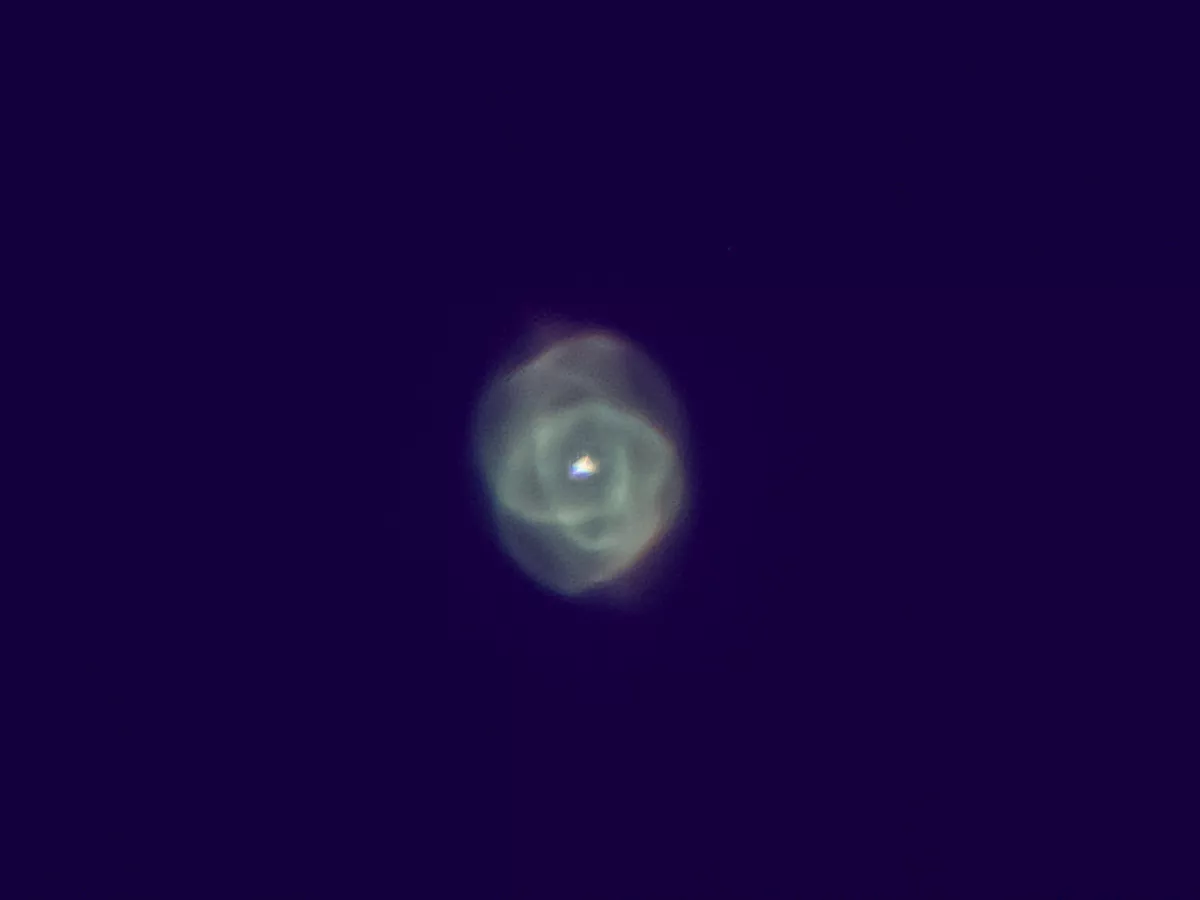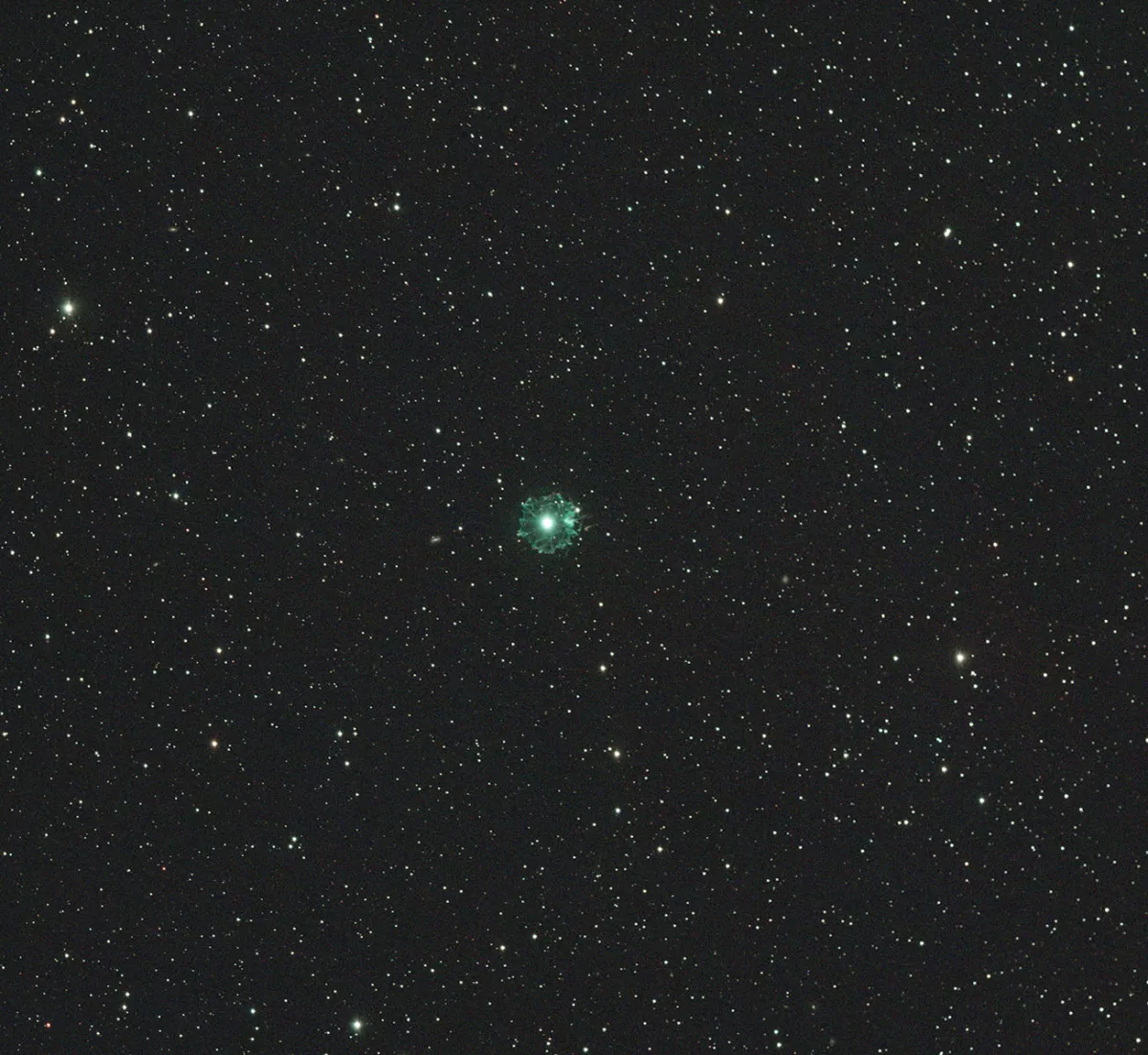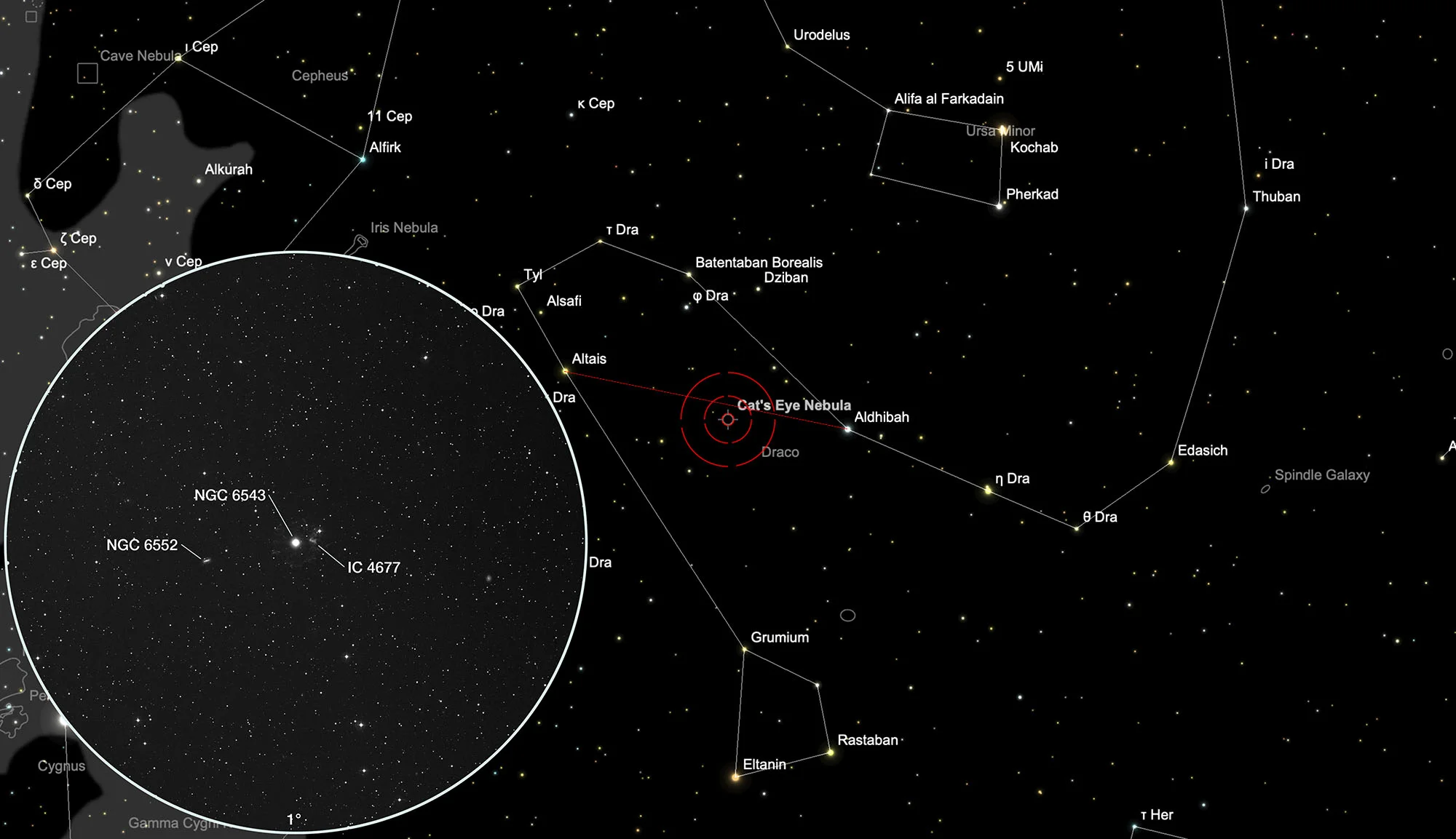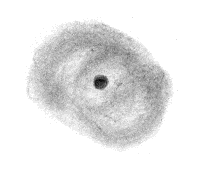Cat's Eye Nebula (NGC 6543)

Object Description
NGC 6543 is among the most complex planetary nebulae. The HST false-color image (Fig. 2) reveals a complicated structure of the nebula with concentric shells of gas, high-velocity jets of gas, and unusual shock-wave-induced gas knots. Because of its appearance, NGC 6543 was named the Cat's Eye Nebula.
Its age is estimated at around 1000 years and its distance at 3000 to 3600 light years. So it is still relatively young. The nebula shows the dynamics and late evolution of a dying star. The diameter of the bright core region of the nebula is estimated at about 20'000 AU, that of the outer, much fainter envelope at about 3.5 light-years.

According to a preliminary study, the central star is said to be a binary star system that is too close together to be separated from the HST. The dynamics of two orbiting stars could explain these complex structures of the nebula. According to this model, a fast stellar wind from the two central stars created the dense, elongated, luminous envelope of gas. This structure is embedded in two larger «lobes» which the star shed in an earlier phase. These lobes are «pinched» by a ring of denser gas thought to lie on the orbital plane of the binary system. The suspected companion could also be responsible for a pair of high-speed jets perpendicular to the equatorial ring. If the companion sucks matter from the other star, jets could shoot away along the companion's axis of rotation. These jets would explain some swirling properties along the perimeter of the gas lobes. Like a jet of water slicing through a pile of sand, these jets could compress opposing gas, creating the «curlytail» formations and bright arcs at the outer edge of the lobes. These two jets are now pointing in a different direction than these formations, suggesting that they are wobbling or precessing and ebb and flow periodically. X-rays are also received from these jets, a rarity for planetary nebulae.

This false-color image, obtained with the Hubble Space Telescope's Wide Field Planetary Camera-2, is a composite of three different images at different wavelengths. The «red color» in the image corresponds to the hydrogen alpha line (656.3 nm), the «blue color» corresponds to the neutral oxygen line (630.0 nm) and the «green color» corresponds to the ionized nitrogen line (658.4 nm) . For us, all of these emission lines are in the red spectral range. So this recording does not provide any information about the true color composition. [4, 114, 162]
| Designations | PN G096.4+29.9: NGC 6543, PK 96+29.1, ARO 6, VV 143, VV' 335 |
| Right Ascension (J2000.0) | 17h 58m 33s |
| Declination (J2000.0) | +66° 37' 59" |
| Dimensions | 19.5" (optical), 15." (radio) |
| Distance | 0.89 kpc |
| Radial Velocity | -66.1 ± 0.4 km/s |
| Expansion Velocity | 19.5 (O-III) 20. (N-II) km/s |
| C-Star Designations | AG +66 812, AG82 279, BD +66 1066, DC 36017, EM* CDS 945, GCRV 10447, HD 164963, PLX 4128.0 |
| C-Star Magnitude | B: 11.23, V: 11.14 |
| C-Star Spectral Type | Of/WR(H) |
| Discoverer | HERSCHEL 1786 |
IC 4677

In Fig. 4 the halo of NGC 6543 can be seen, showing some ragged differences in brightness. It measures about 350 arc seconds in diameter. Just west of the central star is a bright, diffuse, elongated patch within the halo. That spot was first seen by Barnard on 24 April 1900 and added as IC 4677 to the second edition «Index Catalogue» by Dreyer. [277] It was first thought to be a galaxy, why it was added to galaxy catalogs such as the «Morphological Catalogue of Galaxies» (MCG) and the «Principal Galaxies Catalogue» (PGC). IC 4677 has an atypical appearance for galaxies. Rather, it seems to be an early violent outburst of gas from the central star of NGC 6543, which, together with the large halo and the numerous smaller and fainter wisps of gas, makes it quite likely. According to the Simbad database, IC 4677 is part of NGC 6543. The Lyon-Meudon Extragalactic Database (LEDA) also confirms this. [134] It also shines mainly in the O-III range, which is extremely strange for galaxies.
| Designation | IC 4677 |
| Type | PN |
| Right Ascension (J2000.0) | 17h 58m 15.7s |
| Declination (J2000.0) | +66° 38' 02" |
| Diameter | 1.1 × 0.7 arcmin |
| Photographic (blue) magnitude | 15.7 mag |
| Position Angle | 60° |
| Metric Distance | 1.626 kpc |
| Dreyer Description | vF, S, IV. 37 f 16s.5 |
| Identification, Remarks | MCG 11-22-17, VV 121, part of N 6543 |
Galaxy NGC 6552
From our perspective east of the Cat's Eye this time lies a real, distant and therefore visually small and faint galaxy, NGC 6552. It was discovered by d'Arrest on 6 October 1866. Dreyer described it as faint, fairly small and irregular. It can be seen on the left edge of Fig. 4. The galaxy is moving away from the Local Group at a speed of about 8100 km/s. The angle between the axis of rotation and the line of sight is 45 degrees. [134] [134]
About four arc minutes south of NGC 6552 is the north pole of the ecliptic, around which the north celestial pole rotates at an angular interval of 23.5 degrees due to the precession of the Earth's axis.
| Designation | NGC 6552 |
| Type | Gx (SBbc) |
| Right Ascension (J2000.0) | 18h 00m 07.0s |
| Declination (J2000.0) | +66° 36' 55" |
| Diameter | 1 × 0.7 arcmin |
| Photographic (blue) magnitude | 14.5 mag |
| Visual magnitude | 13.7 mag |
| Surface brightness | 13.1 mag·arcmin-2 |
| Position Angle | 105° |
| Redshift (z) | 0.026492 |
| Distance derived from z | 111.9 Mpc |
| Dreyer Description | F, pS, iR |
| Identification, Remarks | UGC 11096, MCG 11-22-18, CGCG 322-26, KUG 1800+666, IRAS 18001+6638 |
How to find Cat's Eye Nebula?
The Cat's Eye is in the Dragon constellation. At low magnifications, NGC 6543 is barely distinguishable from a mag 8 star. However, it can be easily identified by the prominent straight line of five stars running roughly north-south. The PN is at the northern end and forms roughly a right angle with the last star. Although the PN is circumpolar, it is highest in the sky at night during the months of March to September and can thus be best observed.

Visual Observation

300 mm aperture: The Cat's Eye also visually reveals a lot of its complicated structure. At a low magnification of about 26x, it can hardly be distinguished from a bright star. He's just a little thicker. The halo with the strange object IC 4677 is not discernible, this requires a little more aperture.
With increasing magnification, in contrast to the stars, the diameter and the richness of detail of the nebula increases. The very bright central star can best be seen at about 120x, above which the structures of the nebula dominate. These can best be seen at high magnification in a high-contrast eyepiece, but their visibility is heavily dependent on the calm of the air. The transparency of the atmosphere plays less of a role.
At 500x the nebula shows an appearance that resembles that of a pretzel, but a cat's eye can also be interpreted into it, especially since the differences in brightness are too small for a pretzel. Sometimes one also has the feeling that different, sometimes contradictory structures can be recognized with each new viewing, but these can be filtered out with longer viewing.
In principle, the only limits to the magnification are the imaging quality of the telescope optics, the eyepieces and the air turbulence. The nebula itself is so bright that it can be seen well even at 1000x. An O-III or an H-beta filter brings practically no increase in contrast with this object.
The galaxy NGC 6552 appears as a small, faint ellipse with no structure.